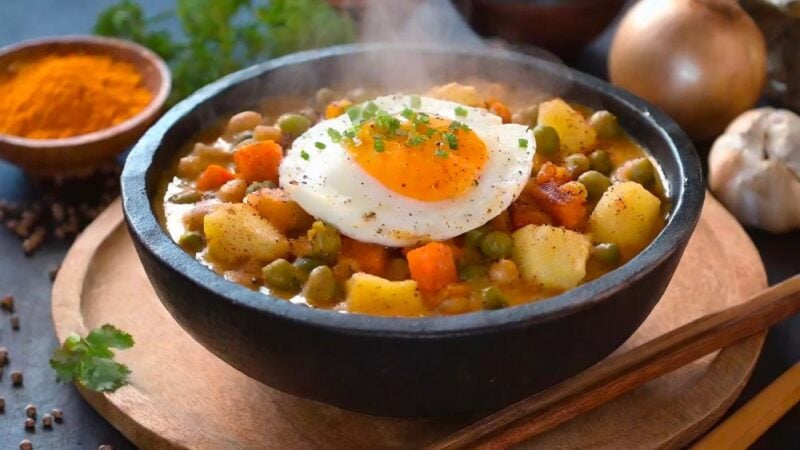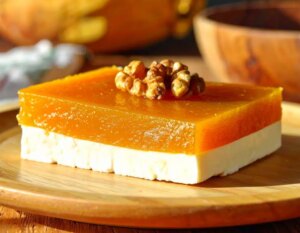
Hello friends of the world! Today we are going to see a very Latin American recipe originating and typical of Chile. Charquicán is a traditional Chilean stew and comforting.
Preparation varies according to regions and family preferences. To make it, the meat is boiled until it is very tender and the jerky is added if it is the preference of the diners or the cook. It also has vegetables so it is very complete.
It is generally served as main dish and reflects the rich Chilean culinary tradition. Like any stew, prior preparation takes time, but then you just have to let the slow heat do its thing.
About the charquicán
The charquicán is a Iconic Chilean dish that fuses local ingredients into a tasty and comforting stew. Its origin dates back to colonial times, when charqui (dehydrated meat) was used to preserve meat.
The recipe varies, but commonly includes beef, potatoes, carrots, corn, zucchini, onion, garlic and cumin. The versatility allows it to be adapted to personal preferences.
Some recipes include additional ingredients such as pepper and peas. This dish is a culinary expression rooted in Chilean culture, served hot as a main coursehighlighting the richness of local products and creativity in the kitchen.
How is this Chilean stew prepared?
Preparing charquicán, a traditional Chilean dish, involves combining simple ingredients for a tasty and comforting stew. First of all, beef is boiled until tender, and jerky is optionally added to enhance the flavor.
Then they join potatoes, carrots, corn, zucchini, onion and garlic, all cut into pieces. The mixture is cooked until the vegetables are soft, allowing the flavors to meld.
The versatility of this recipe allows it to be adapted according to preferences, resulting in a homemade dish full of tradition and warmth. It is usually accompanied with fried eggs on top as in the recipe for eggs rancheros or halved hard-boiled eggs.
Vegetarian charquican
The vegetable charquicán is a vegetarian variant of the classic Chilean dish, highlighting the abundance of fresh vegetables in its preparation. This stew dispenses with meat, focusing on ingredients such as potatoes, carrots, corn, zucchini, onion and garlic, all cut into generous pieces.
The absence of meat highlights the natural flavors of the vegetables, creating a light and nutritious dish. Cumin remains a key element to provide that distinctive touch.
The recipe with vegetables is a delicious and healthy option that celebrates the diversity of plant products, maintaining the comforting essence of this traditional Chilean recipe.
Where does the word charquican come from?
The word “charquicán” It has its origins in Quechua, a South American indigenous language. It comes from the combination of two terms: “charqui”, which refers to dehydrated and preserved meat, and “can”, which means stew or stew..
Altogether, it refers to a stew that traditionally incorporates jerky, but over time, the recipe evolved to include various ingredients such as fresh meat, potatoes, carrots and other vegetables. This adaptability reflects the cultural richness of Chilean gastronomy, fusing indigenous and colonial elements in a comforting and tasty dish.
Origin of the charquican recipe
The charquicán has roots in the colonial era of Chile and its name comes from Quechua, an indigenous South American language. Originally, it was prepared with dehydrated and preserved meat, a technique used to preserve food.
Over time, the recipe evolved, incorporating fresh meat and a variety of local vegetables. This dish represents the fusion of indigenous and colonial influences in Chilean gastronomy, highlighting the adaptability of the recipe through the centuries. It has become a culinary icon that reflects the rich history and diversity of Chile.
Summary of the charquicán in 5 points
- Indigenous Origin: It has its roots in the indigenous traditions of Chile. The word “charquicán” comes from Quechua, an indigenous South American language, and originally implied the use of charqui, dehydrated meat.
- Adaptability: Over time, it has undergone adaptations in its ingredients. Although it initially included mainly charqui, the recipe has evolved to incorporate a variety of fresh meats and vegetables, showing the versatility of Chilean cuisine.
- Plato Familiar: Charquicán is a dish associated with family and home cooking. Its preparation often involves the participation of multiple generations, passing down recipes and cooking techniques from parents to children.
- Celebration of Plant Diversity: There are vegetarian variants of charquicán, highlighting the abundance of fresh vegetables in Chilean cuisine. This adaptation demonstrates how the recipe can be adjusted to meet different preferences and dietary needs.
- Presence at Festive Events: Although enjoyed year-round, charquicán is often served at family celebrations and festivities, adding a touch of tradition to special events in the lives of people in Chile.
Follow me on Instagram (here)
And on YouTube I upload new videos every week (click here)
Charquicán recipe
Yield: 6 servings
Preparation time: 40 minutes
Ingredients
- 500 g of beef (can be pork, goose or similar), cut into pieces
- 1 cup crumbled jerky
- 4 medium potatoes, peeled and cut into cubes
- 2 carrots, peeled and sliced
- 1 cup fresh or frozen corn
- 1 zucchini, cut into cubes
- 1 chopped onion
- 2 cloves garlic, minced
- 1 teaspoon cumin
- 1 bay leaf
- Salt and pepper to taste
- Cooking oil
- Vegetable broth or water (about 4 cups)
Step by step to make the charquicán
- In a pot, heat a little oil and brown the meat over medium heat. Then add the jerky.
- Add the onion and garlic to cook until golden. Stir in the potatoes, carrots, corn and zucchini so they are mixed well.
- Add the cumin, salt, pepper and bay leaf. Pour in enough vegetable broth or water to cover the ingredients and bring to a boil.
- Reduce the heat to low, cover the pot and simmer for about 30-40 minutes or until the vegetables are tender. Adjust flavors and serve hot.

Source: www.paulinacocina.net


